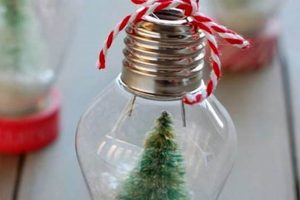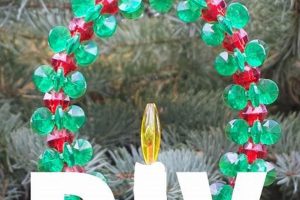The creation of decorative items from felt, specifically designed for adornment and involving a do-it-yourself approach, constitutes a popular crafting activity. An example includes hand-sewing small, festive shapes from felt scraps and embellishing them with beads and embroidery to hang on a tree or give as gifts.
This type of handicraft offers several advantages, including affordability, accessibility for various skill levels, and opportunities for personalization. Historically, handmade ornaments have provided a personal touch to celebrations, representing family traditions and creative expression. The use of felt, a relatively inexpensive and easy-to-handle material, expands access to crafting for a wider audience.
The subsequent sections will delve into specific design ideas, material selection guidelines, essential techniques, and resources for individuals interested in pursuing this engaging pastime. The construction process, from initial concept to final embellishment, will be detailed.
Tips for Successful Felt Ornament Creation
The following recommendations aim to enhance the quality and longevity of handcrafted decorative felt pieces. Adhering to these guidelines will facilitate a more satisfying crafting experience and result in durable, visually appealing ornaments.
Tip 1: Select high-quality felt. Opt for wool or wool-blend felt over synthetic alternatives. Superior felt resists pilling and maintains its shape better over time.
Tip 2: Employ sharp scissors or rotary cutters. Clean, precise cuts are essential for achieving professional-looking edges. Dull blades can fray the felt, compromising the overall aesthetic.
Tip 3: Utilize appropriate thread. Choose thread that complements the felt’s color and composition. Cotton or polyester thread works well for most felt projects. Ensure the thread is strong enough to withstand repeated handling.
Tip 4: Secure embellishments meticulously. When attaching beads, sequins, or buttons, use a strong adhesive or sew them on securely. Loose embellishments detract from the ornament’s appearance and pose a safety hazard, especially for ornaments intended for use around children.
Tip 5: Consider the ornament’s intended use. If the ornament will be subject to frequent handling, reinforce seams and edges. For delicate designs, consider using a stabilizer to prevent distortion.
Tip 6: Maintain symmetry and balance in design. Pay attention to the placement of design elements to create visually pleasing ornaments. Use templates or stencils to ensure consistency in shape and size.
Tip 7: Store felt ornaments properly. When not in use, store ornaments in a cool, dry place away from direct sunlight. Place delicate ornaments in individual bags or containers to prevent damage.
By following these guidelines, individuals can create felt ornaments that are both aesthetically pleasing and enduring. These tips promote craftsmanship and ensure the longevity of handcrafted decorations.
The next section will address common challenges encountered during the crafting process and offer solutions for overcoming these obstacles.
1. Material Selection
The selection of materials forms a foundational element in the creation of durable and visually appealing felt ornaments. The quality, type, and characteristics of the chosen materials directly influence the final product’s appearance, longevity, and overall aesthetic.
- Felt Fiber Composition
The composition of the felt itself, whether wool, synthetic, or a blend, dictates its texture, durability, and resistance to wear. Wool felt, derived from animal fibers, offers superior quality, resisting pilling and retaining shape effectively. Synthetic felt, often made from acrylic or polyester, provides a more economical alternative, albeit with reduced longevity and a potentially less refined appearance. The fiber content affects the ease of stitching, the felt’s ability to hold its form, and the vibrancy of colors.
- Thread Type and Strength
The choice of thread for joining felt pieces and adding decorative elements is crucial. Cotton thread, while widely available, may lack the strength and durability required for long-lasting ornaments. Polyester thread, known for its resilience and resistance to fading, represents a more suitable option for projects intended to withstand repeated handling. The thread color should complement or contrast the felt, depending on the desired visual effect.
- Embellishment Materials
Beads, sequins, buttons, and embroidery floss contribute to the ornament’s aesthetic appeal and level of detail. The quality of these embellishments influences the overall appearance. Glass beads, for example, offer a greater sparkle and perceived value compared to plastic alternatives. Similarly, the type of embroidery floss used impacts the texture and richness of the embroidered details. Care must be taken to ensure embellishments are securely attached to prevent detachment and potential hazards.
- Stabilizers and Interfacing
In certain instances, particularly with intricate designs or delicate felt, stabilizers or interfacing may be necessary to provide structural support. These materials prevent the felt from stretching or distorting during the stitching process and ensure that the ornament maintains its intended shape. The selection of stabilizer depends on the weight and type of felt being used, with fusible options offering ease of application.
The deliberate selection of appropriate materials significantly enhances the outcome of the handcrafted felt ornament. Careful consideration of fiber composition, thread strength, embellishment quality, and the potential need for stabilizers ensures a finished product that is both visually appealing and structurally sound, thereby maximizing its potential to become a cherished keepsake.
2. Design Complexity
Design complexity, in the context of felt ornament creation, directly influences project duration, required skill level, and ultimately, the aesthetic outcome. Ornaments featuring simple geometric shapes, basic stitching, and minimal embellishments represent low-complexity designs accessible to novice crafters. Such designs minimize the risk of error and allow for rapid completion, making them suitable for large-scale production or group crafting activities. For example, a simple star or heart shape cut from felt and embellished with a few basic stitches demonstrates minimal design complexity. Conversely, intricate designs incorporating multiple layers of felt, elaborate embroidery, detailed embellishments, and advanced stitching techniques constitute high-complexity projects. These require significant time investment, specialized skills, and meticulous attention to detail.
The selection of an appropriate design complexity level is critical for ensuring a satisfying crafting experience and achieving desired results. Attempting a highly complex design without sufficient experience can lead to frustration, errors, and a suboptimal finished product. Conversely, limiting oneself exclusively to simple designs may stifle creativity and prevent the development of more advanced crafting skills. Intermediate designs, incorporating a balance of simple and complex elements, offer a suitable pathway for gradual skill progression. Examples include layered felt ornaments with basic embroidery or simple shapes adorned with more intricate beadwork.
Understanding the relationship between design complexity and the overall felt ornament crafting process is essential for both project planning and skill development. By carefully assessing personal skill level and available time, individuals can select designs that offer a rewarding challenge without being overly daunting. Furthermore, recognizing the impact of design complexity on the final aesthetic enables crafters to make informed decisions regarding material selection, embellishment choices, and stitching techniques, ultimately contributing to the creation of unique and visually appealing felt ornaments.
3. Stitching Technique
Stitching technique represents a critical component within the craft of felt ornament construction. The choice and execution of stitching directly influence the structural integrity, aesthetic appeal, and overall durability of the finished ornament. A poorly executed stitch can compromise the ornament’s form, lead to premature wear, and detract from its visual quality. Conversely, a well-chosen and skillfully applied stitch enhances the ornament’s strength, adds a decorative element, and contributes to its long-term preservation.
Several stitching techniques are commonly employed in felt ornament creation, each offering distinct advantages and disadvantages. The blanket stitch, for example, provides a robust and decorative edge finish, preventing fraying and adding a clean, defined border. The running stitch offers a simpler and faster alternative for joining felt layers, albeit with reduced durability compared to the blanket stitch. Backstitch is frequently used for adding fine details and outlining shapes, providing precision and control. In contrast, whipstitch offers a faster option for joining edges together. A real-world example of the impact of stitching technique can be observed in comparing two felt ornaments: one constructed with a running stitch exhibiting fraying edges and a separating seam after moderate use, while the other, employing a blanket stitch, maintains its structural integrity and aesthetic appeal over a prolonged period.
In summary, the selection and proficient execution of stitching techniques are paramount for successful felt ornament projects. Understanding the properties and applications of various stitch types empowers crafters to create ornaments that are not only visually appealing but also structurally sound and enduring. Overcoming the challenge of mastering specific stitches requires practice and attention to detail, ultimately leading to the production of high-quality, handcrafted decorations that can be enjoyed for years to come. This understanding is inextricably linked to the success of crafting felt ornaments and ensuring their lasting value.
4. Embellishment Choices
The selection of embellishments significantly impacts the aesthetic quality and perceived value of handcrafted felt ornaments. These choices transcend mere ornamentation, reflecting the crafter’s artistic vision and influencing the ornament’s overall character.
- Beads and Sequins
Beads and sequins introduce texture, dimension, and reflective qualities to felt ornaments. Glass beads, often favored for their superior luster, elevate the ornament’s perceived quality. Sequins, available in diverse shapes and finishes, offer opportunities for creating shimmering effects. The strategic placement of beads and sequins can accentuate specific design elements, drawing attention to focal points within the ornament. Overuse, however, may detract from the felt’s inherent texture and create a visually cluttered appearance. The selection of color and size must complement the overall design.
- Embroidery Floss and Thread
Embroidery floss facilitates the creation of intricate surface designs, adding depth and complexity to felt ornaments. Varied stitching techniques, such as satin stitch, backstitch, and French knots, allow for a wide range of textural effects. Thread color choice impacts visual contrast and influences the ornament’s overall style. Metallic threads introduce a subtle shimmer, while matte threads offer a more subdued effect. Careful planning of embroidery patterns enhances the ornament’s visual appeal and conveys a sense of craftsmanship.
- Buttons and Charms
Buttons and charms contribute to the ornament’s thematic character, adding a touch of whimsy or nostalgia. Vintage buttons, for example, can evoke a sense of timelessness, while themed charms reinforce the ornament’s subject matter. Secure attachment of buttons and charms is essential for preventing detachment and ensuring the ornament’s longevity. The size and scale of these embellishments must be proportionate to the overall ornament dimensions, avoiding an unbalanced or overwhelming appearance.
- Ribbons and Lace
Ribbons and lace introduce texture and visual interest to felt ornaments, softening edges and adding a delicate touch. Satin ribbons offer a smooth, lustrous finish, while velvet ribbons provide a richer, more luxurious feel. Lace trims introduce intricate patterns and delicate details, enhancing the ornament’s overall elegance. The careful selection of ribbon or lace color and width complements the ornament’s design and reinforces its intended aesthetic. Secure attachment prevents fraying and ensures the embellishment remains intact.
The deliberate application of embellishments transforms a simple felt shape into a unique and personalized ornament. These choices impact not only the ornament’s visual appeal but also its tactile qualities and overall perceived value, contributing significantly to the enjoyment derived from its creation and display.
5. Finishing Touches
The final stages of felt ornament construction, often designated as “Finishing Touches,” represent a critical phase in determining the overall quality and longevity of the handcrafted item. These steps, while seemingly minor, are pivotal in transforming a partially completed project into a polished and enduring decoration.
- Thread Management
The meticulous trimming and securing of loose threads is paramount. Protruding threads detract from the ornament’s aesthetic and pose a potential hazard. Securing thread ends, either by knotting and concealing them within the felt layers or using a specialized adhesive, prevents unraveling and ensures the ornament maintains its integrity over time. Neglecting thread management results in a perceived lack of craftsmanship. For instance, an otherwise well-executed ornament may appear amateurish if visible threads are left untrimmed. Securing threads is crucial for safety, especially for ornaments intended for children.
- Seam Reinforcement
Areas subjected to stress, such as seams connecting multiple felt layers or points of attachment for embellishments, require reinforcement. Additional stitching, strategically placed, strengthens these vulnerable areas, preventing separation or tearing. Applying a fabric adhesive to the reverse side of seams provides supplemental support. Omission of seam reinforcement leads to premature failure, particularly with ornaments that are frequently handled or subjected to movement. A small amount of reinforcement can significantly extend the ornament’s lifespan.
- Edge Treatment
The treatment of exposed felt edges impacts both the ornament’s appearance and its resistance to wear. Applying a thin layer of fabric sealant to edges prevents fraying and provides a clean, defined finish. Alternatively, decorative stitching, such as a blanket stitch or whip stitch, can be employed to encase the edges and add visual interest. Unprotected edges are prone to unraveling, diminishing the ornament’s aesthetic and reducing its durability. A well-executed edge treatment enhances the ornament’s perceived value and contributes to its long-term preservation.
- Presentation and Storage
Consideration should be given to how the finished ornament will be presented and stored. Attaching a hanging loop or ribbon allows for immediate display. Storing ornaments in individual bags or containers protects them from dust, moisture, and physical damage. Proper presentation enhances the ornament’s perceived value, while appropriate storage ensures its continued enjoyment for years to come. A simple muslin bag, for example, offers protection while allowing the ornament to be viewed.
These seemingly small actions significantly amplify the impact and quality of the project. These practices ensure longevity and aesthetic appeal, ultimately transforming a simple craft into a treasured keepsake.
Frequently Asked Questions
The subsequent section addresses common inquiries and clarifies prevalent misconceptions regarding the crafting of felt ornaments. The information presented aims to provide clear, concise answers, promoting a better understanding of essential techniques and best practices.
Question 1: What is the optimal type of felt for ornament construction?
Wool or wool-blend felt is generally considered superior due to its durability, resistance to pilling, and ability to hold its shape. Synthetic felt offers a more economical alternative but may lack the longevity and aesthetic appeal of natural fibers.
Question 2: How can fraying edges be prevented on felt ornaments?
Applying a fabric sealant to exposed edges, employing a blanket stitch or whip stitch to encase the edges, or utilizing pinking shears to create a decorative edge can mitigate fraying.
Question 3: What is the recommended method for attaching embellishments to felt ornaments?
A strong adhesive, such as fabric glue, or hand-sewing the embellishments directly onto the felt is recommended. The chosen method should ensure a secure and lasting attachment.
Question 4: How can symmetry be achieved when cutting felt shapes for ornaments?
Utilizing templates or stencils and carefully tracing the design onto the felt before cutting can promote symmetry. Folding the felt in half before cutting can also ensure mirrored shapes.
Question 5: What stitching technique provides the most robust seam for joining felt pieces?
The blanket stitch offers a durable and decorative edge, effectively securing felt pieces together and preventing separation. Backstitch is also strong and is good for details.
Question 6: How should felt ornaments be stored to maintain their quality?
Storing ornaments in individual bags or containers, in a cool, dry place away from direct sunlight, protects them from dust, moisture, and physical damage.
The preceding answers provide a foundation for informed decision-making in felt ornament projects. Applying these principles leads to a higher likelihood of crafting durable, aesthetically pleasing decorations.
The following section explores advanced techniques and creative embellishment ideas to further enhance the crafting experience.
Conclusion
The preceding discussion elucidated critical aspects of crafting decorative felt ornaments. Exploration encompassed material selection, design complexity, stitching techniques, embellishment choices, and essential finishing touches. Emphasis was placed on the significance of quality materials, precise execution, and thoughtful design considerations to achieve both aesthetic appeal and structural integrity. Best practices and methods have been provided.
The information presented serves as a foundational resource for individuals seeking to engage in “felt ornament diy.” Further application of these principles and continued exploration of design possibilities will foster creativity and skill development. The enduring value of handcrafted items lies in their ability to reflect personal expression and cultural traditions; therefore, commitment to quality craftsmanship and thoughtful design remains paramount.







